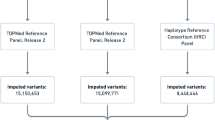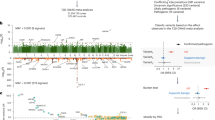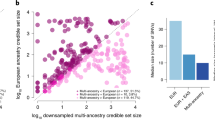Abstract
A GAA-repeat in the X25 gene is causing Friedreich's ataxia (FRDA), a common neurodegenerative disease and >20% of FRDA patients develop type II diabetes (T2D). Linkage has previously been detected between T2D and chromosome 9p13–q21, the region that harbours the X25 gene, but association studies of this gene in T2D have been contradicting. Here, we examined whether genetic variation in the X25 gene is associated with risk for T2D. The GAA-repeat and 18 single nucleotide polymorphisms (SNPs) covering the X25 gene were genotyped in 220 trios in which the affected offspring had abnormal glucose tolerance. Any nominally significant findings were examined in an independent sample consisting of 523 individuals with T2D and 326 healthy controls. Previously reported results were analysed together with our data using a meta-analysis approach. There was no association between the GAA-repeat and T2D susceptibility in our study, which was supported by the meta-analysis including all previous publications. One SNP (rs2498429), 8.2 kb downstream of X25, was nominally associated with T2D in the trios (P=0.02) and showed a trend of association in the same direction in the case–controls (P=0.08; combined permuted P=0.01). Further analysis showed that the nine-marker haplotype containing the rare allele of rs2498429 was nominally associated with T2D in the trios (P<0.01) as well as in the case–controls (P=0.03). In conclusions, this study excludes a role of genetic variation within the X25 gene, but instead suggests that genetic variation downstream the X25 gene, may increase risk for T2D.
Similar content being viewed by others
Log in or create a free account to read this content
Gain free access to this article, as well as selected content from this journal and more on nature.com
or
References
Alberti KG, Zimmet PZ : Definition, diagnosis and classification of diabetes mellitus and its complications. Part 1: diagnosis and classification of diabetes mellitus provisional report of a WHO consultation. Diab Med 1998; 15: 539–553.
Finocchiaro G, Baio G, Micossi P, Pozza G, di Donato S : Glucose metabolism alterations in Friedreich's ataxia. Neurology 1988; 38: 1292–1296.
Campuzano V, Montermini L, Molto MD et al: Friedreich's ataxia: autosomal recessive disease caused by an intronic GAA triplet repeat expansion. Science 1996; 271: 1423–1427.
Hanis CL, Boerwinkle E, Chakraborty R et al: A genome-wide search for human non-insulin-dependent (type 2) diabetes genes reveals a major susceptibility locus on chromosome 2. Nat Genet 1996; 13: 161–166.
Lindgren CM, Mahtani MM, Widen E et al: Genomewide search for type 2 diabetes mellitus susceptibility loci in Finnish families: the Botnia study. Am J Hum Genet 2002; 70: 509–516.
Luo TH, Zhao Y, Li G et al: A genome-wide search for Type II diabetes susceptibility genes in Chinese Hans. Diabetologia 2001; 44: 501–506.
Pratley RE, Thompson DB, Prochazka M et al: An autosomal genomic scan for loci linked to prediabetic phenotypes in Pima Indians. J Clin Invest 1998; 101: 1757–1764.
Imperatore G, Hanson RL, Pettitt DJ, Kobes S, Bennett PH, Knowler WC : Sib-pair linkage analysis for susceptibility genes for microvascular complications among Pima Indians with type 2 diabetes. Pima Diabetes Genes Group. Diabetes 1998; 47: 821–830.
Delatycki MB, Knight M, Koenig M, Cossee M, Williamson R, Forrest SM : G130 V, a common FRDA point mutation, appears to have arisen from a common founder. Hum Genet 1999; 105: 343–346.
Campuzano V, Montermini L, Lutz Y et al: Frataxin is reduced in Friedreich ataxia patients and is associated with mitochondrial membranes. Hum Mol Genet 1997; 6: 1771–1780.
Babcock M, de Silva D, Oaks R et al: Regulation of mitochondrial iron accumulation by Yfh1p, a putative homolog of frataxin. Science 1997; 276: 1709–1712.
Mootha VK, Lindgren CM, Eriksson KF et al: PGC-1alpha-responsive genes involved in oxidative phosphorylation are coordinately downregulated in human diabetes. Nat Genet 2003; 34: 267–273.
Filla A, De Michele G, Cavalcanti F et al: The relationship between trinucleotide (GAA) repeat length and clinical features in Friedreich ataxia. Am J Hum Genet 1996; 59: 554–560.
t’Hart LM, Ruige JB, Dekker JM, Stehouwer CD, Maassen JA, Heine RJ : Altered beta-cell characteristics in impaired glucose tolerant carriers of a GAA trinucleotide repeat polymorphism in the frataxin gene. Diabetes 1999; 48: 924–926.
Dalgaard LT, Hansen T, Urhammer SA, Clausen JO, Eiberg H, Pedersen O : Intermediate expansions of a GAA repeat in the frataxin gene are not associated with type 2 diabetes or altered glucose-induced beta-cell function in Danish Caucasians. Diabetes 1999; 48: 914–917.
Dupont S, Dubois D, Vionnet N et al: No association between the Friedreich's ataxia gene and NIDDM in the French population. Diabetes 1998; 47: 1654–1656.
Lynn S, Hattersley AT, McCarthy MI, Frayling TM, Turnbull DM, Walker M : Intermediate expansions of a X25/frataxin gene GAA repeat and type II diabetes: assessment using parent–offspring trios. Diabetologia 2000; 43: 384–385.
Ristow M, Giannakidou E, Hebinck J et al: An association between NIDDM and a GAA trinucleotide repeat polymorphism in the X25/frataxin (Friedreich's ataxia) gene. Diabetes 1998; 47: 851–854.
Shadrina MI, Miloserdova OV, Slominskii PA, Balabolkin MI, Limborskaiia SA : Association of polymorphic trinucleotide repeat (GAA)n of the Frataxin gene with diabetes mellitus type 2 in the Moscow population. Mol Biol (Mosk) 2002; 36: 37–39.
Groop L, Forsblom C, Lehtovirta M et al: Metabolic consequences of a family history of NIDDM (the Botnia study): evidence for sex-specific parental effects. Diabetes 1996; 45: 1585–1593.
Tripathy D, Carlsson M, Almgren P et al: Insulin secretion and insulin sensitivity in relation to glucose tolerance: lessons from the Botnia Study. Diabetes 2000; 49: 975–980.
Edelstein SL, Knowler WC, Bain RP et al: Predictors of progression from impaired glucose tolerance to NIDDM: an analysis of six prospective studies. Diabetes 1997; 46: 701–710.
Shaw JE, Zimmet PZ, de Courten M et al: Impaired fasting glucose or impaired glucose tolerance. What best predicts future diabetes in Mauritius? Diabetes Care 1999; 22: 399–402.
O’Connell JR, Weeks DE : PedCheck: a program for identification of genotype incompatibilities in linkage analysis. Am J Hum Genet 1998; 63: 259–266.
Purcell S, Cherny SS, Sham PC : Genetic power calculator: design of linkage and association genetic mapping studies of complex traits. Bioinformatics 2003; 19: 149–150.
Gabriel SB, Schaffner SF, Nguyen H et al: The structure of haplotype blocks in the human genome. Science 2002; 296: 2225–2229.
Spielman RS, McGinnis RE, Ewens WJ : Transmission test for linkage disequilibrium: the insulin gene region and insulin-dependent diabetes mellitus (IDDM). Am J Hum Genet 1993; 52: 506–516.
Kruglyak L, Daly MJ, Reeve Daly MP, Lander ES : Parametric and nonparametric linkage analysis: a unified multipoint approach. Am J Hum Genet 1996; 58: 1347–1363.
Clayton D : A generalization of the transmission/disequilibrium test for. Am J Hum Genet 1999; 65: 1170–1177.
Zhao JH, Lissarrague S, Essioux L, Sham PC : GENECOUNTING: haplotype analysis with missing genotypes. Bioinformatics 2002; 18: 1694–1695.
Zhao JH : 2LD, GENECOUNTING and HAP: computer programs for linkage disequilibrium analysis. Bioinformatics 2004; 20: 1325–1326.
Altshuler D, Hirschhorn JN, Klannemark M et al: The common PPARgamma Pro12Ala polymorphism is associated with decreased risk of type 2 diabetes. Nat Genet 2000; 26: 76–80.
Gloyn AL, Weedon MN, Owen KR et al: Large-scale association studies of variants in genes encoding the pancreatic beta-cell KATP channel subunits Kir6.2 (KCNJ11) and SUR1 (ABCC8) confirm that the KCNJ11 E23K variant is associated with type 2 diabetes. Diabetes 2003; 52: 568–572.
Jorde LB : Linkage Disequilibrium and the Search for Complex Disease Genes. Genome Res 2000; 10: 1435–1444.
Melton D, Brown J, Kenty G et al: Endocrine Pancreas Consortium, 2000, http://www.ncbi.nlm.nih.gov/, Accession number: BM022009.
Acknowledgements
We thank the Botnia families for their support and willingness to participate and for making this project possible. This work was supported by grants from the Sigrid Juselius Foundation, the JDF Wallenberg Foundation, the Ingabritt and Arne Lundbergs Foundation, the Finnish Diabetes Research Foundation, The Swedish Medical Research Council, the Novo-Nordisk Foundation, and a European Commission grant to Genome Integrated Force in Type 2 Diabetes (GIFT), the Royal Physiographic Society in Lund, ‘Diabetesföreningen i Malmö med omnejd’, the Medical Faculty of Lund University. The Royal Physiographic Society, Novartis Foundation and The Swedish Medical Research Council support CML.
Author information
Authors and Affiliations
Corresponding author
Additional information
Supplementary Information accompanies the paper on European Journal of Human Genetics website (http://www.nature.com/ejhg)
Supplementary information
Rights and permissions
About this article
Cite this article
Holmkvist, J., Almgren, P., Parikh, H. et al. Haplotype construction of the FRDA gene and evaluation of its role in type II diabetes. Eur J Hum Genet 13, 849–855 (2005). https://doi.org/10.1038/sj.ejhg.5201413
Received:
Revised:
Accepted:
Published:
Issue date:
DOI: https://doi.org/10.1038/sj.ejhg.5201413



